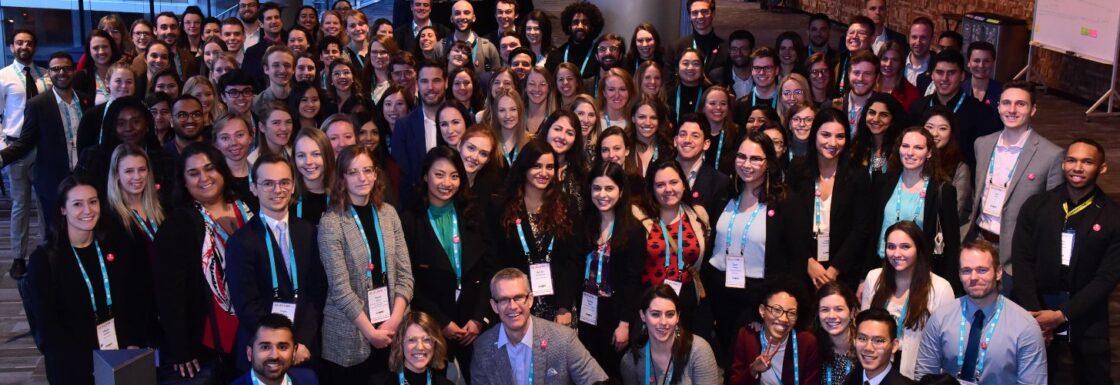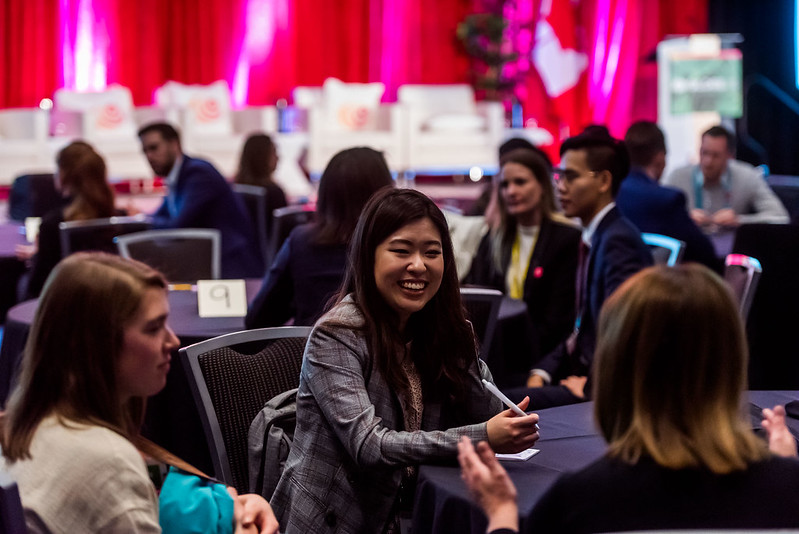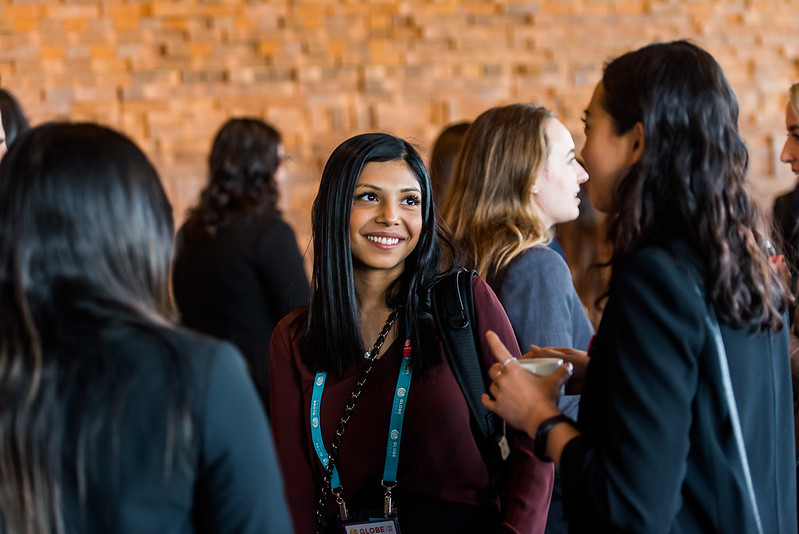If Change Moves at the Speed of Trust, Then We Need to Take Relationships and Network-Building Seriously

In the last few years, we’ve seen profound shifts in public consciousness and support for environmental and social issues. The release of the 2018 IPCC Special Report on the impacts of global warming of 1.5°C above pre-industrial levels, 2019’s global student-led climate strikes, and most recently, the COVID-19 global pandemic has resulted in greater citizen and shareholder concern for environmental risks and acknowledgment of social injustices.
As a result, more and more start-ups, task forces, campaigns, events, and other initiatives to drive environmental and social change are cropping up across the country. Nowhere is this more apparent than amongst today’s youth and young adult demographic. The ecosystem of youth-led sustainability work in Canada is wide-ranging and teeming with life, from professionalized groups, youth-led ENGOs, and grassroots community organizers to cleantech entrepreneurs and corporate sustainability intrapreneurs.
This collective momentum is exciting – and essential – as the window for the tremendous amount of change required to stay within scientifically determined planetary boundaries and meet globally recognized human well-being targets closes. Scientists and other experts have advised that in order to address a global challenge as complex and far-reaching as climate change, as many people as possible from all walks of life will need to take action. If change moves at the speed of trust (a concept attributed to the late businessman and educator Stephen Covey), then trusting relationships between different camps within the system need to be built.
Why is building a coordinated network of Canadian environmental youth leaders important?
Today’s young Canadian environmental leaders don’t often have the opportunity to come together in the same arena. That should concern anyone who wants to safeguard the country’s future livability, security, and overall well-being of its citizens and ecosystems. A fragmented and siloed approach to youth sustainability efforts stagnates progress and potentially hinders this generation’s ability to pull together under stressful events in the future.
This is a nut that Leading Change Canada has been trying to crack. Leading Change is a national nonprofit that supports Canadian youth and young professionals (ages 19-35) working across different disciplines, sectors, geographic locations, and ideological lines. Since 2003 we’ve supported roughly 2,000 young environmental advocates to expand their personal and professional circles. The scope of our work is multi-sector, interdisciplinary, non-partisan, and covers a broad range of interconnected environmental issues, including climate change, circular economy, and sustainable finance.
We view our organization’s role within this rich ecosystem as the “connective tissue”; uniting and serving a cross-country network of young Canadians motivated to be part of the transition to a cleaner and fairer economy. Sharing best practices, details on emerging projects, and on-the-ground personal insights helps avoid duplicating efforts and competition while actually improving and bolstering change-making initiatives. It also allows young people to reach across the aisle and build long-term relationships with people they may not always see eye to eye with.
Our Theory of Change is predicated on building trusting relationships across a fragmented, and at times polarized landscape of youth-led environmental efforts. We believe a resilient, coordinated, national network is needed to accelerate the transition towards a low-carbon and socially just economy. Time is of the essence, and we simply can’t afford to have anyone sitting on the proverbial sidelines.
Key learnings from building a network of young Canadian leaders
Perhaps not surprisingly, bringing together young people who hold different opinions on the best pathway to change doesn’t come without its challenges. During my time at the helm of Leading Change, I’ve had my fair share of uncomfortable conversations, moments where plans were challenged, and moments where my mind was changed.
Below are a few key things I’ve come to appreciate as critical for building an inclusive, diverse, and supportive network.

1. Ask who isn’t at the table or who needs more seats.
The environmental sector has historically and continues to be dominated by white formally educated settlers. We see a duty for our organization to break this pattern of homogeneity and advocate for the inclusion of youth historically and currently underrepresented in Canadian positions of leadership and power. This has meant intentionally making space and centring voices from Black, Indigenous, racialized, refugee, LGBTQIA2S+, visible religious minority, and disability communities.
Some of the work has meant setting explicit minimum representation targets and holding ourselves accountable to meeting them. We have worked with other NGO partners as well as our alumni to support outreach and awareness within their communities, and modify modified application forms to be more accessible, inclusive, and culturally sensitive.
In tandem, we’ve recognized the importance of educating our program participants on equity-related concepts so that everyone enters with a baseline understanding and appreciation for different lived experiences. This pre-work has included readings based on Kimberlé Crenshaw’s analytical framework of intersectionality, anti-oppression training, and reflective activities on land acknowledgments and Indigenous reconciliation.
We’ve also had to adjust our annual and program budgeting to account for things like funding to reduce barriers to travel, compensation for participants contributing emotional labour, various accessibility measures, and on-site emotional support resources such as Indigenous elders. Securing funds to support crucial anti-racism and accessibility measures continues to be a challenge for ENGOs such as ours. However the upcoming federal election shakes out, I hope that initiatives such as Canada’s Anti-Racism Strategy and Enabling Accessibility Fund will continue to be national priorities.
2. Find the balance between creating a space for like-minded individuals and becoming an echochamber.
The most common on-ramp to our network has been through our flagship program, the Leading Change Forum. The Forum is a biennial leadership summit that brings together 150 young people from across the country. One of the biggest challenges we’ve encountered when selecting the youth delegation is avoiding becoming an echo chamber of perspectives that are too like-minded.
To help mitigate this, we had to expand our definition of what an environmental advocate was or could be. In the not-so-distant past, we prioritized young people who were squarely studying or working in an environmental field. This has since shifted to a broader focus on sustainability and welcoming in people working on various social and economic issues. At the onset of any of our programs, we now identify specific targets that include proportional geographic representation, industry and sector diversity, and representation across all 17 interlinked UN Sustainable Development Goals.
There’s, of course, always room to improve and bring additional perspectives into the fold. We see opportunities to engage with more young people across the country, including more rural and northern representation, blue-collar workers, and right-of-centre viewpoints.

3. Create spaces that are brave.
Producing the most robust solutions to the stickiest sustainability challenges requires more than just someone playing devil’s advocate. Researchers at the University of Berkeley have found that the best group decisions are made when authentic dissent and opposing opinions are brought to the table.
In the summer of 2020, we invested time and staff resources to better understand how we could create brave spaces that foster civil dialogue and allow participants to show up as their full selves. A brave space can be described as “a productive dialogue where participants are encouraged to speak honestly and critically from their own experience toward the end of mutual learning and liberation” (via City Bureau).
One of the outputs of this work was a set of a dozen group agreements that we employ in nearly all of our programs and internal-facing work. They represent our values as an organization and capture the challenging yet supportive spirit of collaboration we wish to see our participants take out into the world. Agreements may be built on or modified by participants depending on the tasks, challenge context, or group’s composition. We also developed facilitator training and handout materials for our staff and volunteers alike.
The COVID-19 global pandemic has resulted in our usual in-person programming pivoting to online spaces for the time being (and likely to continue in some form into the foreseeable future as the benefits of bringing together a national network virtually are numerous). Facilitating online spaces brings its own set of challenges when body language and non-verbal cues are more difficult to pick up on. Nevertheless, there are strategies for hosting virtual sessions that allow participants to express themselves in the way they feel most comfortable – whether with their camera on or off, through a chat function, or using one of the many visual online collaboration tools available.
4. Unite around a common vision.
Leading Change is fortunate to operate in a constellation model with other Canadian sustainability organizations, including The Delphi Group, GLOBE Series, EXCEL Partnership, and Canadian Business for Social Responsibility (CBSR). Although each entity holds its own distinctive mission and leadership, we share a common vision of achieving a sustainable, prosperous, and socially just future within a generation.
This is the same vision that unites our young constituents and the many mentors, speakers, and partners we work with. It’s a vision that’s broad enough for everyone to see themselves contributing to, even if there’s disagreement on the best way to get there.
In contrast to shorter-term advocacy campaigns, the “within a generation” in our vision means taking a long-term view – say out to 2050 when we will have ostensibly achieved all our net-zero emissions targets. For today’s young people, that means the bulk of their professional career will be spent working towards this vision. Along the way, they’re likely to weave in and out of different sectors, organizations, and even political views.
As the impacts of the climate change crisis and other environmental issues become more urgent, they will need strategies, connections, psychosocial support, and encouragement to stay in the fight. If we can equip them with a network of peers, mentors, and challengers to turn to, they’ll stand a better chance of being more bold, assertive, and empathetic when taking action.














